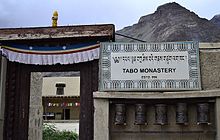Our website is made possible by displaying online advertisements to our visitors.
Please consider supporting us by disabling your ad blocker.
Tabo Monastery
| Tabo Monastery | |
|---|---|
 Tabo Gompa – old walls and chortens, 2004. | |
| Religion | |
| Affiliation | Tibetan Buddhism |
| Sect | Gelug |
| Leadership | Geshe Sonam Wangdui |
| Location | |
| Location | Spiti Valley, Himachal Pradesh, India |
| Country | India |
| Geographic coordinates | 32°4′48″N 78°22′48″E / 32.08000°N 78.38000°E |
| Architecture | |
| Style | 9 temples, 4 Stupas, 23 chortens, monks quarters |
| Founder | Rinchen Zangpo |
| [1] | |
Tabo Monastery (or Tabo Chos-Khor Monastery[1]) is located in the Tabo village of Spiti Valley, Himachal Pradesh, northern India. It was founded in 996 CE in the Tibetan year of the Fire Ape[2] by the Tibetan Buddhist lotsawa (translator) Rinchen Zangpo (Mahauru Ramabhadra), on behalf of the king of western Himalayan Kingdom of Guge, Yeshe-Ö.[2] Tabo is noted for being the oldest continuously operating Buddhist enclave in both India and the Himalayas.[3] A large number of frescoes displayed on its walls depict tales from the Buddhist pantheon.[4] There are many priceless collections of thankas (scroll paintings), manuscripts, well-preserved statues, frescos and extensive murals which cover almost every wall. The monastery is in need of refurbishing as the wooden structures are aging and the thanka scroll paintings are fading.[5] After the earthquake of 1975, the monastery was rebuilt, and in 1983 a new Du-kang or Assembly Hall was constructed. It is here that the 14th Dalai Lama held the Kalachakra ceremonies in 1983 and 1996.[6][7] The monastery is protected by the Archaeological Survey of India (ASI) as a national historic treasure of India.[7]
- ^ "Taboe Ancient Monastery: Ajanta of the Himalayas". Tabo in Spiti Valley. Retrieved 20 January 2013.
- ^ a b Deshpande 2005, p. 666.
- ^ Klimburg-Salter, Deborah E. (1997). Tabo: a lamp for the kingdom : early Indo Tibetan Buddhist art in the western Himalaya. Skira. p. 39. ISBN 9788881182091. Retrieved 20 January 2013.
- ^ "HP to promote temple tourism". Tribune News Service. 8 October 2000. Retrieved 20 January 2013.
- ^ "Heritage status sought for Tabo monastery". Tribune News Service. 15 September 2003. Retrieved 20 January 2013.
- ^ Kapadia (1999), p. 64.
- ^ a b Cite error: The named reference
aawas invoked but never defined (see the help page).
Previous Page Next Page




